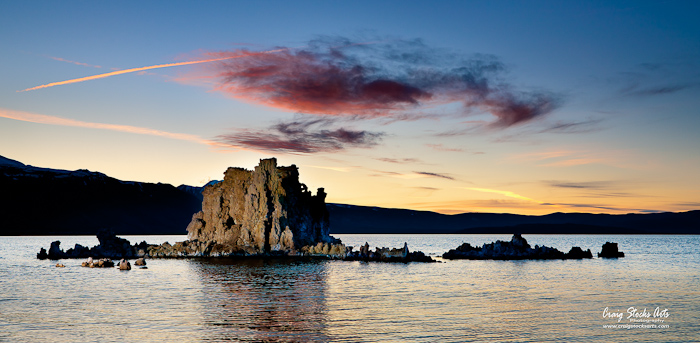I recently posted a new tutorial explaining some of the story behind the photo below. One of the unusual aspects of the photo is that I used a strobe off-camera to light up the tuffa. Without the flash, the tuffa would have appeared as a silhouette and would have blended into the silhouette of the mountains in the background.

I just finished matting and framing a rather large version of this photo, and it reminds me again about the difference between “taking” a picture and “making” a picture. I’m not talking about Photoshop manipulation. I’m referring to all of the work that needs to be done between capturing the exposure and producing a final, professional quality print.
It was also a good reminder that creating a finished print is a part of photography that is disappearing. In the old days (i.e. film era) you had to make a print of your photograph if you wanted to easily share or display the image. A print is a tangible thing you can hold in your hand. You can look at it any time you want, and you don’t depend on some other technology to create the experience, you just look at it. When you’re done looking at it, you can choose to display it somewhere, or you can put it away out of sight. But, it’s still a thing, and it still exists.
A print is also a permanent rendering of the artists intent. The blue sky and the red clouds are the colors I intended. I even choose the size of the display, and an appropriate mat and frame to show the print at its best.
I worry that digital photography is taking that experience away from us. It’s certainly not an inherent flaw of digital photography, it’s our reaction to the perceived ease of sharing digital images online. It’s certainly cheaper to simply upload an image on the internet, and let people look at it. In theory, every person in the world could look at the picture. But their experiences will be different. Some will see the picture on a large, clear monitor where the colors closely match what I saw on my monitor. Others will look at the picture on the tiny screen of their super-duper cell phone, and they’ll have a different experience. As an artist, I want to create and share a visual experience, but I can only control the experience if I make an image into a finished print.
I think there will also be a very different perception of value. I doubt if anyone would pay to view the image online. And, an image file doesn’t have much value as an object. I can make as many free copies as I like. I can make backup copies, so that I don’t have to worry about losing it. Digital pictures displayed online, or even stored on a DVD just don’t have much perceived value.
But a framed and matted print is a different matter. Certainly there’s the cost of the materials. Then, there’s the cost of my time to make the print and assemble the whole thing. There’s also the artistic value that comes from my choices of color, size, materials, and precision in putting it all together. Hopefully, the artistic value raises the value of the whole thing to something more than the cost of materials. But even if it doesn’t, I have the satisfaction of knowing I produced a thing, and I’m happy with the result.

Pingback: The Trona Pinnacles near Ridgecrest, California - Craig Stocks Arts Blog